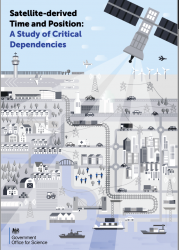Experts who studied GNSS vulnerabilities for the British government recommended GNSS receiver standards, the possible banning of jammers and the establishment of a terrestrial backup in case satellite navigation is disrupted.
Their January 30 report Satellite-derived Time and Position: A Study of Critical Dependencies, looks sector by sector at how signals from global satellite navigation systems have become integrated into the United Kingdom’s essential underpinnings.
“The purpose of this report,” wrote the study’s 16-person panel, “is to lay out the breadth, scale and implications of our reliance on GNSS. It examines this reliance mainly in terms of existing critical national infrastructure (CNI) but also considers future digitally-based infrastructure – such as 5G, electricity system management, autonomous vehicles and the Internet of Things – and other non-critical applications, which GNSS will continue to enable.”
The study found that half a dozen sectors – telecommunications, emergency services, energy, finance, food and transportation – were dependent or were becoming dependent in some way on GNSS signals for getting precise time, position or both.
The impact of a glitch or failure in either timing or position can be substantial. For example, on June 5, 2013, Thomson Reuters caused manufacturing data from the U.S. Institute for Supply Management to go out to high-frequency traders 15 milliseconds before it was supposed to. While the cause was not traced to GNSS, the report said, the result – some $28 million in shares changing hands – illustrates the nature of the problem. GNSS disruptions, they wrote, could result in market manipulations, trading interruptions, volatility and losses.
Problems in the other sectors could also be severe: increased food costs, local blackouts, life-threatening delays in emergency services, travel disruptions, transport delays and increased costs across the board.
“GNSS applications are pervasive, deeply embedded, critical and dynamic,” the authors wrote, so much so that signals from global satellite navigation systems now present “a potential single point of failure affecting multiple services and applications.”
Interest in Action
The findings of the report were not altogether unexpected, however – in fact they echo those from studies previously done in the United States. The interest in addressing the problem, however, appears more serious.
“If you take all the recommendations, and if they are implemented, they are an indication that the government is taking ownership of the problem – and not only taking ownership of the problem but doing so at cabinet level,” said David Last, a professor at the University of Bangor and a member of the expert panel.
That puts the effort at the highest executive level, rather as if the White House was driving the effort. As things now stand in the U.S., work to address GNSS vulnerabilities is being done at the department level – by, for example, the Departments of Homeland Security, Defense and Transportation – and has been dragging on for years due to wrangling over budgets and authority.
The report is actually the second done by the British government. The first, entitled Economic impact to the UK of a disruption to GNSS looked at what kind of damages would result from a five-day loss of GNSS. Looking across numerous sectors the economists estimated in April 2017 that the U.K. economy would take a hit of 5.173 billion British pounds.
To its great credit our government commissioned these two reports, said Last. “The economists said, ‘You’ve got a real problem here and it’s going to cost you a load of money.’ ” The new technology report was remarkable, he said, in that there was, from the beginning, “almost total unanimity on the fact that there is a serious problem and that we need to tackle it and we need to do so at a high level.”
“As you know,” he told Inside GNSS, “there are countries that are still deep in denial that there is any vulnerability or deep in denial that there is any vulnerability that their particular navigation system won’t solve. Europe is full of such countries. The U.S. has been very grown up about it in recognizing the vulnerabilities, but it just hasn’t yet tackled them. And our government is both recognizing them and saying it’s going to tackle it.”
Recommendations
The new report made 11 different recommendations ranging from a formal assessment of the reliance of GNSS for critical infrastructure and a review of whether GNSS jammers should be banned to the establishment of interference monitoring, a backup for GNSS signals and GNSS receiver standards.
The U.S. has discussed the similar recommendations for years. Standards for GNSS receivers have been controversial because of their potential impact on innovation. The issue has also been caught up in the debate over interference from services that some telecommunications companies want to implement in frequency bands near those used by GNSS.
“Once you start to set standards they become set in stone and it becomes more difficult to innovate,” acknowledged Last, “but there are various levels of standards. Simply setting standards so that receivers actually comply with the interface control documents would be a good first step. We have had a number of quite serious events such as the timing event of last year where it turned out that many of the receivers did not even comply with the standards of the transmissions.”
“We’ve seen any number of examples of poorly designed receivers that don’t work in some instances,” said Dana Goward, president of the Resilient Navigation and Timing Foundation and a contributor to the U.K. report. “We had the thousands of receivers in Japan and Korea that were used in the first responder radio systems that failed when the Air Force did an upgrade – in accordance with the interface specification.”
The standards recommendation, added Last, is also aimed at critical infrastructure. “So, you can begin to set standards there I think for CNI (critical national infrastructure) receivers without hog-tying the whole of the commercial market.”
The issue of creating a backup is also a key recommendation of the report.
“If you look at the two reports – the financial report, the London Economics report, said very clearly there are two systems that offer the most benefit to the most areas of application. One of them is eLoran and the other, interestingly, was Satelles,” said Last. “ELoran was name-checked as one to go for.”
The new report tried to be technology neutral, he said. The panel did not recommend eLoran by name – except for noting that, for marine applications, eLoran met international standards. Even so, the report does recommend a terrestrial radio system backup as a mitigation across the board for telecommunication, finance, energy, emergency services and the transportation sectors of aviation, road, rail and maritime. (For the food sector disruptions to transport are considered the biggest risk.)
“So, eight out of eight (of the sector recommendations) say that a terrestrial system would be the answer to a maiden’s prayer,” said Last.
The talk of using a terrestrial radio system as a backup “certainly recalls to me when a representative from the United Kingdom was talking about this to the (National Space-Based Positioning, Navigation, and Timing) Advisory Board a year or two ago,” said Goward, whose organization as advocated for eLoran. “He said it doesn’t seem to make sense to back up space with space. You can certainly use other space (systems) to help your one space solution along – but in terms of backup and complement and resiliency, it doesn’t seem to make sense to do that.”






